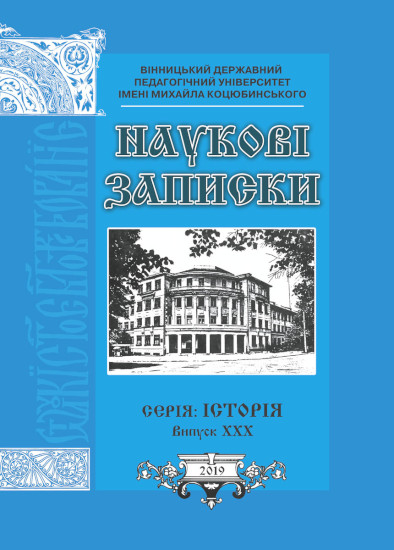Abstract
The purpose of gender is to consider food, its preparation and consumption not as a particular sphere of culture, which is in relation to conditionality with the historical, social and, in fact, cultural context, but as one of the most effective means of physical survival.
Nutrition as a whole is one of the major problems of anthropology, since it has shaped identity and fellowship throughout the history of human culture. However, when it comes to the interwar period (1918 - 1939) and the Ukrainian political emigration of the so-called "second wave" in the Czechoslovak Republic, the historical and political context, that is, the impossibility, is also involved in understanding the concept of "food as a cultural phenomenon". treat food in isolation from politics.
The theoretical development of this problem field is almost absent.
The Ukrainian emigration community in the interwar CSR numbered about 20-22 thousand people. And, it should be emphasized, these were the very persons who deliberately went abroad after the defeat of the National Liberation Competitions of 1917 - 1921. This was the answer to the question why the nutrition of Ukrainian emigrants was meeting the purely biological need of the organism.
The life of «Ukrainian Prazhany» in the interwar CSR was conditionally separated for several periods. According to these periods, «emigration food» was also classified. The historically famous Ruská pomocná akce «Russian Aid Action» also has the same years. It was at this time that cooperative cafes were opened in Prague and Poděbrady, where traditional Ukrainian dishes were cooked: borscht (with and without meat), buckwheat porridge, breaded bread cutlets, dumplings, stuffed cabbages, fried river fish, boiled mashed potatoes, stew in sour cream, pies with different stuffing. Dining rooms prepared Czech, Belarusian, Armenian and Georgian cuisines.
The situation had changed since mid-1925, when Ruská pomocná akce began to collapse and it became clear that «Bolshevism was not dying». The so-called «turn» began. And since the beginning of the 1930s, the global economic crisis, which had lasted in the Czechoslovak Republic until 1935, was added to full «emigration happiness».
The Crown was rapidly depreciating, but prices were rising steadily. After all, the closed labor market was closed for all, without exception, of the «Ukrainian Рrazhany». At this time, representatives of the Ukrainian emigration community are beginning to cook their own products such as eggs, chicken, horse, cheese (cottage cheese), herbs, honey.
The most difficult was the period from 1934 to 1939. Due to total unemployment, the Ukrainian emigration community, for the most part, moved to Transcarpathia, the province of the Czechoslovakia, where despite political and economic nuances, it was somewhat easier to spend. However, at that time, the Czechs were preparing, for example, frogs' legs and crow soup.
For the interwar Ukrainian emigration to the Czechoslovakia, food was, in fact, the satisfaction of basic physical need.
References
Геніюш Л. Споведзь. Мінск: Мастацкая література, 1993. 264 с.
Єфіменко Г. Особливості дослідження повсякдення міжвоєнного періоду // «Історія повсякденності: теорія і практика»: матеріали Всеукр. наук. конф., Переяслав-Хмельницький, 14-15 трав. 2010 р. / [Упоряд.: Лукашевич О. М., Нагайко Т. Ю.]. Переяслав-Хмельницький. 2010. 246 с.
Зубко О. Є. Створення та діяльність Українського вищого педагогічного інституту ім. М. Драгоманова в Празі (1923 – 1933 рр.): дис… канд. іст. наук: 09.00.12. Київ: КНУ ім. Тараса Шевченка. 2010. 224 с.
Зубко О. Є. Матеріально-побутове життя українських пражан у 1921–1939 роках: помешкання, харчування, одяг // Часопис української історії / За ред. доктора історичних наук, професора А. П. Коцура. Випуск. 38. Київ, 2018. С. 32 – 41.
Князєва Т. М. Концепт їжі в культурі повсякденності. http://www.info-library.com.ua/libs/stattya/299-kontsept-yizhi-v-kulturi-povsjakdennosti.html
Королів (Старий) В. Згадки про мою смерть. Спомини. Українське видавництво «Добра книжка». 169 випуск. Торонто, 1961. Вибрані твори. Том. 1. 2-ге видання. 204 с.
Ляхоўскі, У. Ад гоманаўцаў да гайсакоў. Чыннасць беларускіх маладзёвых арганізацый у 2-й палове ХІХ – І-й палове ХХ ст (да 1939 г.): манаграфія / У. Ляхоўскі. Беласток: Беларускае гістарычнае таварыства; Вільня: Інстытут беларусістыкі, 2012. 483 с.
Мартос Б. Українська господарська академія в ЧСР. Т. І. Видано Абсольвентами Української Господарської Академії та Українського Технічно – Господарського інституту. Нью-Йорк, 1959. 247 с.
Русова С. Мемуари. Щоденники. Київ: Поліграфкнига, 2004. 544 с.
Сімʼянців В. Інженер-емігрант в Чехо-Словаччині. (1929 – 1945). В-во Юліяна Середяка. Buenos-Aires – Philadelfia. 1978. 220 с.
Центральний державний архів громадських об’єднань України в м. Києві. Ф. 269. Оп. Спр. 92. 286 арк.

This work is licensed under a Creative Commons Attribution 4.0 International License.
Copyright (c) 2021 Scientific Papers of the Vinnytsia Mykhailo Kotsiubynskyi State Pedagogical University. Series: History




